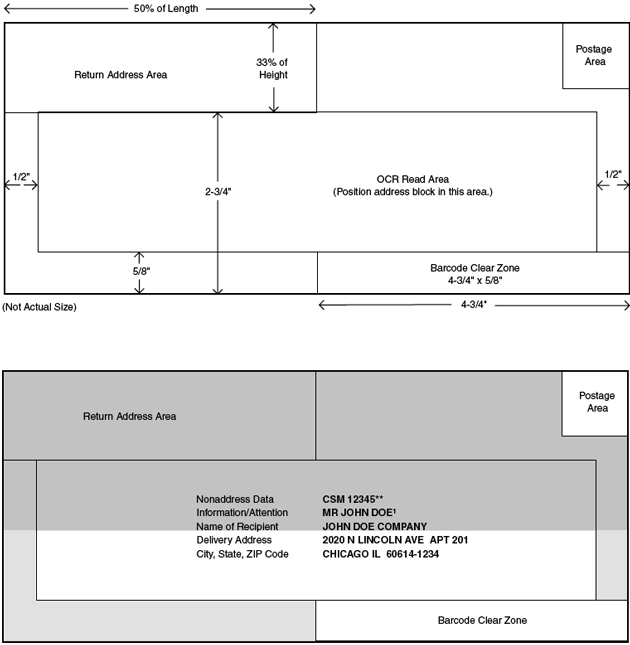| 
Quick Service Guide 602
Basic Standards for All Mailing Services
Addressing
January 2006
Printer-Friendly
PDF
Overview

The delivery address specifies where the USPS is to deliver a mailpiece.
The address must be legible and complete on the side of the mailpiece
that bears the postage.
General Information

Placement and location: see 202.2 for letters and cards, or 302 for flats.
The placement of the address can determine mailability of the mailpiece
and/or rate and eligibility.
See reverse for proper placement of an address block on letter-size
pieces.
Complete Addresses (602.1.4)

The address must include:
- Intended recipient's name or other designation.
- Delivery address (including street number and name (predirectional,
suffix, and postdirectional as appropriate), post office box
number, rural or highway
contract route and box number), and secondary descriptor and number (e.g.,
suite or apartment number, floor) if needed.
- City and state.
- ZIP Code or ZIP+4 code where required.
The address on automation rate mail must be sufficiently complete to
enable matching the current USPS ZIP+4 File when using current
CASS-certified address
matching
software (708.3). Standardized address
elements are not required.
Return Address (602.1.5)

A return address tells the USPS where the sender wants the mail returned
if it is undeliverable. A return address is required on certain types
of mail. Mail qualifying for Nonprofit Standard Mail
rates must have the name and return address of the authorized nonprofit
organization either on
the outside of the mailpiece or in a prominent location on the material
being mailed (inside the mailpiece) (703.1.5).
Alternative Addressing
Formats (602.3)

Simplified addressing: simplified address format ("Postal Customer")
is used when general distribution is requested to each customer on a
rural route or highway contract route or to each boxholder at a post
office without city carrier service. Government agencies may also use
simplified addressing for official matter being sent to all stops on
city carrier routes and post office boxholders at post offices with city
carrier service.
Occupant addressing: mailer may use "Occupant" (instead of
a recipient's name) with a complete delivery address on mail intended
for selective distribution.
Exceptional addressing: indicates that mailpiece should be delivered
to the current resident if addressee has moved. Exceptional addressing
may not be used on certain types of mail.
Addressing Guidelines

The following guidelines for addressing a mailpiece are in USPS Publication
28, Postal Addressing Standards:
- Use simple sans serif type with uniform stroke thickness.
- Type or machine-print in dark ink on a light background with a
uniform left margin.
- Left-justify every line in the address block.
- Use two-letter state abbreviations.
- Use one space between city and state, two spaces between state
and ZIP+4 code.
- Use appropriate ZIP+4 code (if unknown, use 5-digit ZIP Code).

Additional Resources:
Pub. 25, Designing Letter and Reply Mail
Pub. 28, Postal Addressing Standards
For the specific DMM standards
applicable to this category of mail, consult the DMM sections referenced
above and the general sections
within each
DMM module.

1. For MLOCR FASTforward users, the name of the recipient must appear
in the OCR read area.
Dark shaded area indicates "free space" for nonaddress
printing.
Light shaded area indicates preferred clear zone to enhance readability.
Back to Top

|

